Sustainable procurement, also known as green procurement or sustainable purchasing, occurs when a company adopts and integrates corporate social responsibility (CSR) principles into procurement processes and decisions while also ensuring they meet company requirements.
It goes hand-in-hand with ethical procurement, which involves making sure an organization handles all procurement processes and procedures with ethics in mind.
The key difference is that sustainable procurement goes beyond the organization itself to determine how procurement practices affect the environment, society, and the economy alongside price and quality.
Implementing sustainable procurement in your organization integrates requirements, specifications, and criteria compatible with protecting the environment and society.
It goes beyond not using child labor in developing countries or hazardous materials that can damage the environment and people’s health.
It considers a business’ impact on economic development, natural resources, greenhouse gas and climate change, and overall environmental impacts, as well as social impacts.
Understanding Sustainable Procurement
Sustainable procurement embodies integrating environmental, social, and economic criteria within procurement processes to promote sustainability.
It extends beyond mere transactional exchanges, aiming to minimize adverse impacts on society and the environment while fostering economic development.
This concept encourages businesses to make purchasing decisions that contribute positively to global and local communities, economies, and the planet.
The Three Pillars of Sustainable Procurement
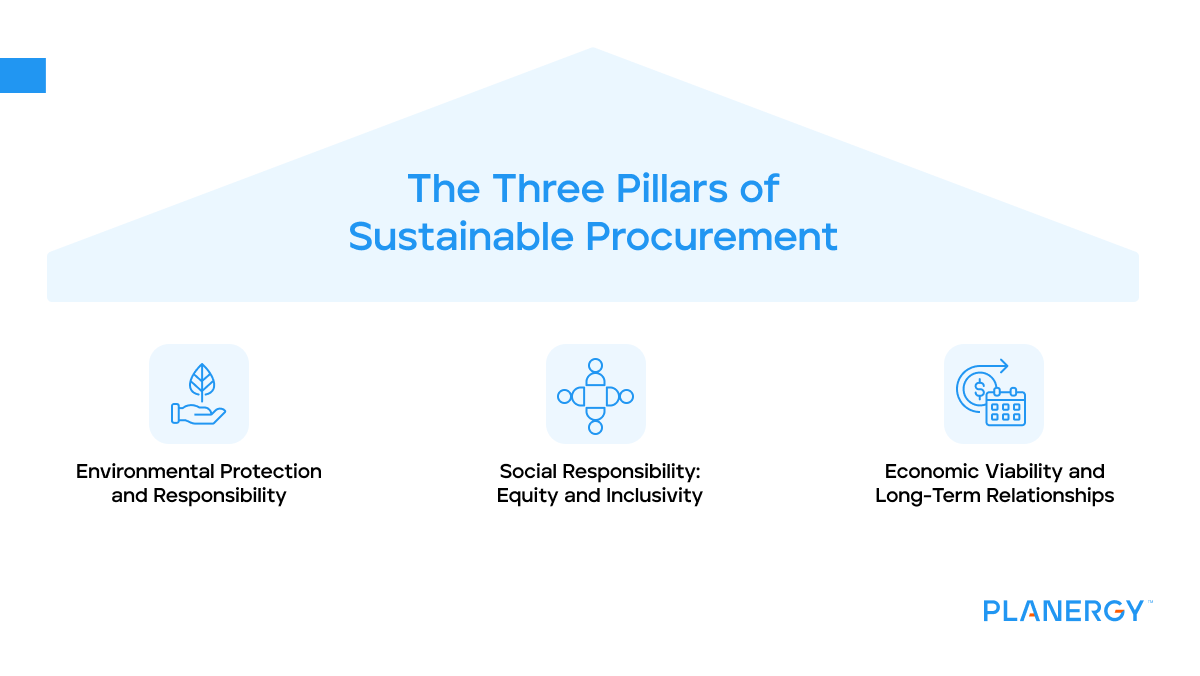
Environmental Protection and Responsibility
Environmental responsibility in sustainable procurement focuses on minimizing the negative environmental impacts of goods and services throughout their life cycle.
This includes reducing carbon emissions, conserving natural resources, and minimizing waste and pollution.
For example, organizations might opt for products made from recycled materials or those requiring less energy consumption for production and operation.
The goal is to contribute to environmental preservation and combat climate change through thoughtful procurement practices.
Social Responsibility: Equity and Inclusivity
Sustainable procurement’s social pillar encompasses human rights, labor laws, fair trade, and community engagement.
It ensures the supply chain does not exploit workers and contributes positively to the communities involved.
This could mean prioritizing suppliers that enforce fair labor practices, provide safe working conditions, and support local development initiatives.
Organizations focusing on social equity and inclusivity can help foster a more equitable global economy.
Economic Viability and Long-Term Relationships
Economic viability refers to making procurement decisions that are financially beneficial in the long run, taking into account the total cost of ownership rather than just the initial purchase price.
This includes considering products’ and services’ durability, maintenance costs, and operational efficiency.
Sustainable procurement encourages building long-term relationships with suppliers committed to sustainable practices, ensuring a stable and ethical supply chain supporting economic growth.
The Benefits of Sustainable Procurement
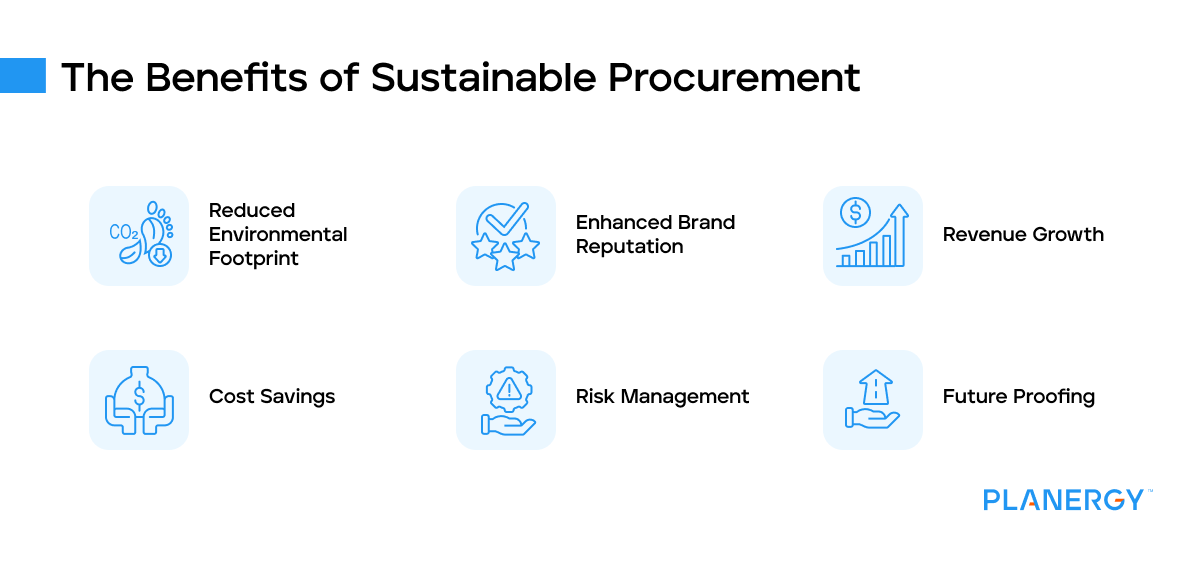
Reduced Environmental Footprint
Organizations can significantly reduce their carbon footprint by prioritizing products and services with lower environmental impacts.
By selecting suppliers and products that prioritize energy efficiency, utilize renewable energy sources, or incorporate low-carbon technologies, companies can significantly reduce the greenhouse gas emissions associated with manufacturing, transportation, and disposal of goods and services.
For instance, opting for suppliers that adhere to sustainable practices can substantially decrease CO2 emissions, aligning with global efforts to combat climate change.
Enhanced Brand Reputation
In today’s market, a company’s commitment to sustainability significantly influences its brand perception and reputation.
Consumers are becoming more environmentally conscious, preferring brands that genuinely commit to sustainability.
A sustainable procurement strategy showcases an organization’s dedication to ethical practices and enhances its appeal to eco-conscious customers, investors, and partners.
This shift in perception can increase customer loyalty, attract socially responsible investment, and open up new market opportunities.
Revenue Growth
Companies that integrate sustainability into their value proposition can differentiate themselves from competitors, creating unique selling points that attract new customers.
Furthermore, sustainable practices often lead to innovations in products, services, and business models, opening up new revenue streams.
For instance, developing eco-friendly products or packaging can capture the attention of a growing segment of environmentally conscious consumers, driving sales and enhancing profitability.
Cost Savings
Sustainable practices often involve optimizing resource use, which can significantly save on raw materials, energy, and waste management costs.
For example, choosing suppliers that use renewable energy or sustainable materials can lower production costs and reduce dependency on volatile commodity markets.
Investing in durable, high-quality products can decrease long-term operational and maintenance expenses, further contributing to financial savings.
Risk Management
By adopting sustainable procurement practices, companies can mitigate risks associated with regulatory compliance, supply chain disruptions, and reputational damage.
For instance, sourcing from suppliers that adhere to environmental and social standards reduces the risk of scandals or legal issues arising from unethical supplier practices.
Moreover, diversifying the supply base with sustainable suppliers can enhance supply chain resilience, protecting against disruptions caused by environmental or social crises.
Future Proofing
Implementing sustainable procurement practices positions companies to navigate future challenges better and capitalize on emerging opportunities.
As global environmental and social governance (ESG) regulations become more stringent, companies with advanced sustainability practices will find it easier to comply with new laws, avoiding penalties and maintaining uninterrupted operations.
It also prepares businesses to meet the evolving expectations of customers, employees, and investors, ensuring long-term viability and success in a rapidly changing world.
Green vs. Sustainable Procurement
While often used interchangeably, green and sustainable procurement are not synonymous.
Green procurement focuses exclusively on environmental aspects, whereas sustainable procurement encompasses a broader scope, incorporating social and economic considerations alongside environmental concerns.
Implementing a Sustainable Procurement Policy
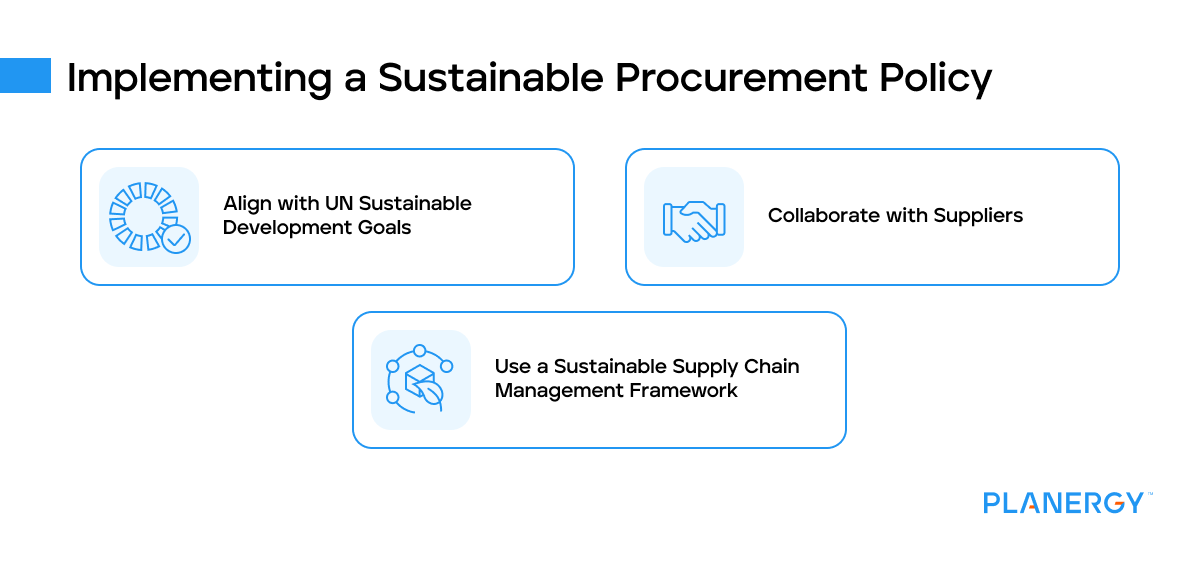
A sustainable procurement policy is a guiding framework for integrating sustainability into procurement activities.
It outlines the organization’s commitments, objectives, and strategies for sustainable procurement.
Align with UN Sustainable Development Goals
Organizations can align their procurement strategies with the United Nations Sustainable Development Goals (SDGs) by identifying and prioritizing procurement activities that contribute to these global objectives, such as responsible consumption and production, climate action, and decent work and economic growth.
Collaborate with Suppliers
Effective collaboration with suppliers is crucial for reducing environmental impacts.
This can involve identifying areas for improvement, sharing best practices, and encouraging or requiring suppliers to adopt more sustainable operations.
Use a Sustainable Supply Chain Management Framework
Leaders can create more sustainable supply chain management frameworks by incorporating sustainability criteria into supplier selection and evaluation processes, fostering transparency and accountability, and investing in technologies that enable more efficient supply chain operations.
Small and medium-sized enterprises (SMEs) can implement sustainable procurement practices by starting with small, manageable changes, leveraging networks and partnerships for shared learning and collaboration, and taking advantage of available resources and tools to support SMEs in adopting sustainable practices.
Introducing Sustainable Procurement Processes
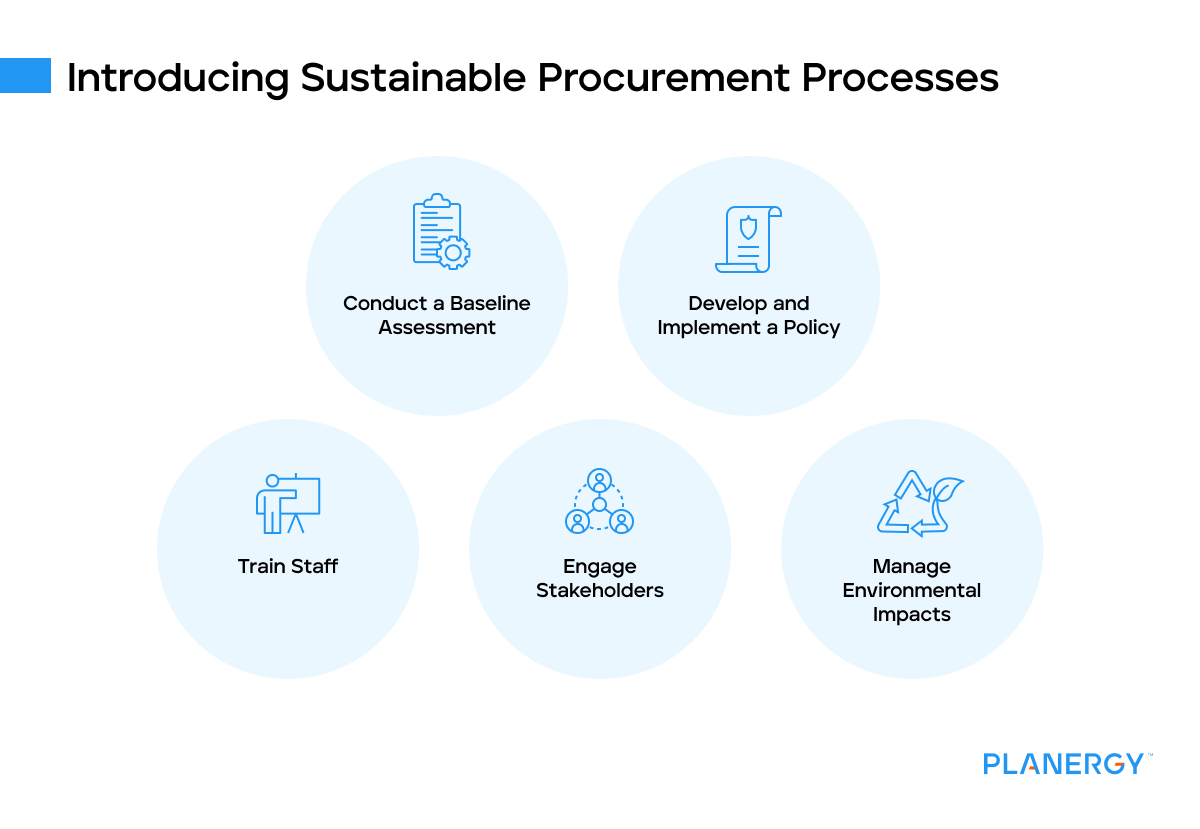
Conduct a Baseline Assessment
Conduct a baseline assessment of current procurement practices.
This involves analyzing existing purchasing policies, procedures, and outcomes to identify areas where sustainability can be integrated or enhanced.
The assessment should cover various dimensions, including environmental impacts, social responsibility, and economic factors associated with procurement activities.
By understanding the current state, organizations can find specific opportunities for improvement and set realistic targets for incorporating sustainability into procurement processes.
Develop and Implement a Policy
Develop and implement a sustainable procurement policy.
This policy should clearly articulate the organization’s commitment to sustainability, outline specific objectives, and establish guidelines for integrating ESG considerations into procurement decisions.
It should also define roles and responsibilities, set performance indicators, and lay out procedures for monitoring and reporting on progress.
A well-crafted policy serves as a foundation for embedding sustainability into the procurement function and guides stakeholders in making decisions that align with the organization’s sustainability goals.
Train Staff
Train procurement staff on sustainable procurement principles.
Staff members need to understand the importance of sustainability in procurement, the specifics of the organization’s sustainable procurement policy, and how to apply sustainability criteria in their day-to-day operations.
Training programs should cover topics such as identifying sustainable suppliers, evaluating products and services based on environmental and social criteria, and negotiating contracts that include sustainability clauses.
By equipping staff with the necessary knowledge and skills, organizations can foster a culture that prioritizes sustainability across all procurement activities.
Engage Stakeholders
Engage stakeholders, including suppliers, to foster collaboration and commitment.
This engagement involves communicating the organization’s sustainability objectives to suppliers and working together to identify areas for improvement.
PLANERGY emphasizes the importance of building strong relationships with suppliers, encouraging them to adopt sustainable practices, and integrating sustainability criteria into supplier selection and evaluation processes.
Through active engagement, organizations can extend their sustainability efforts beyond their immediate operations, contributing to broader positive impacts across their supply chains.
Manage Environmental Impacts
Organizations can manage emissions, energy, waste, and water use by implementing energy-efficient practices and technologies, encouraging renewable energy sources, promoting waste reduction and recycling initiatives, and adopting water-saving measures.
Challenges in Sustainable Procurement
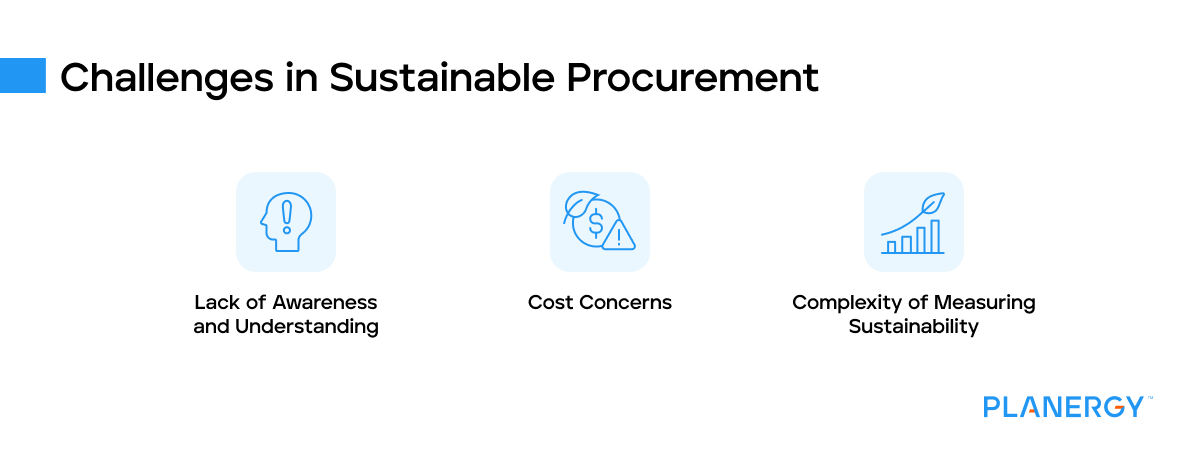
Lack of Awareness and Understanding
A common barrier is the lack of understanding of what sustainable procurement entails and its benefits.
Many organizations and their procurement teams are still unfamiliar with the concept or fail to grasp its full scope, which goes beyond environmental considerations to include social and economic dimensions.
This lack of understanding can lead to resistance or indifference towards adopting sustainable procurement practices.
Cost Concerns
Initial costs can be higher for sustainable products and services, deterring some organizations.
This can deter organizations from making sustainable choices, especially when operating under tight budget constraints.
While it’s true that some sustainable options may have higher upfront costs, organizations need to consider the total cost of ownership, which often reveals that sustainable choices can be more cost-effective in the long run due to their efficiency and durability.
Complexity of Measuring Sustainability
The many factors involved in assessing the sustainability of procurement choices can be complex.
This includes evaluating the environmental impact of products and services, considering the social conditions under which they were produced, and analyzing their economic viability.
The lack of standardized metrics and tools for measuring sustainability further complicates this process, making it challenging for procurement professionals to make informed decisions.
Best Practices for Public Sector Implementation
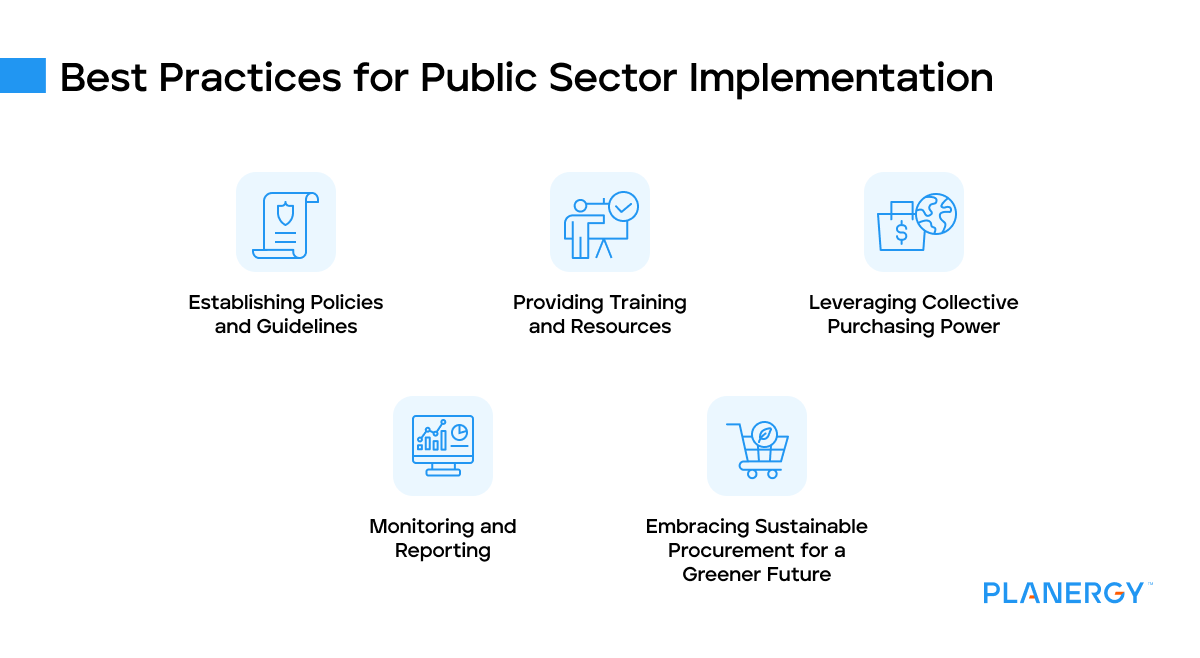
Public sector organizations can adopt several best practices to address these challenges and effectively implement sustainable procurement.
Establishing Policies and Guidelines
Creating clear policies and guidelines is essential for laying the foundation of a sustainable procurement strategy.
These documents should articulate the organization’s commitment to sustainability with a code of conduct, define specific goals and objectives, and provide a framework for integrating sustainability into procurement processes.
Providing Training and Resources
Equipping procurement professionals with the necessary training and resources is crucial for enabling them to make sustainable procurement decisions.
This includes offering educational programs that cover sustainability principles, the benefits of sustainable procurement, and the tools and techniques for assessing sustainability.
Providing access to databases and platforms that offer information on sustainable suppliers and products can also support procurement professionals in their decision-making process.
Leveraging Collective Purchasing Power
Leverage collective purchasing power to influence market offerings.
By collaborating with other organizations and forming purchasing consortia, the public sector can create a demand for sustainable products and services, driving innovation and reducing costs through economies of scale.
Monitoring and Reporting
Monitor and report on progress to ensure accountability and measure the impact of sustainable procurement initiatives.
Organizations should establish key sustainability performance indicators (KPIs) and regularly track their progress against these metrics.
Reporting on achievements and challenges helps evaluate the effectiveness of sustainable procurement practices and demonstrates the organization’s commitment to sustainability to stakeholders.
Common KPIs include:
- Reduced Carbon Emissions
- Improved Supplier Diversity
- Cost Savings
Embracing Sustainable Procurement for a Greener Future
It’s clear that this approach is not just a trend but a necessary shift towards more responsible and conscious business practices.
Sustainable procurement stands at the intersection of environmental stewardship, social responsibility, and economic viability, offering a pathway for organizations to contribute positively to the world while achieving their business objectives.
The benefits of sustainable procurement are manifold and profound.
From enhancing brand reputation and managing risks more effectively to driving cost savings and fostering innovation, the advantages underscore the value of integrating sustainability into procurement strategies.
Moreover, by reducing the environmental footprint, companies not only mitigate their impact on the planet but also align themselves with broader global sustainability goals and consumer expectations.
However, the journey towards sustainable procurement is not without its challenges.
It requires a commitment to change, a willingness to invest in long-term relationships, and a strategic approach to overcoming obstacles.
Organizations must navigate complexities such as cost concerns, sustainability measurement, and ensuring supplier compliance with sustainability standards.
Yet, the potential rewards—environmental conservation, social equity, and economic growth—far outweigh these hurdles.
As we look to the future, sustainable procurement will play a crucial role in shaping more resilient and sustainable economies.
By adopting sustainable procurement practices, businesses can lead by example, driving change within their supply chains and industries.
This collective effort is essential for addressing some of the most pressing challenges of our time, including climate change, resource depletion, and social inequality.
Sustainable procurement represents a powerful lever for driving positive change, offering significant benefits for organizations, society, and the planet.
While challenges exist, the transition to sustainable procurement is not only feasible but imperative for future-proofing businesses.
By embracing sustainable procurement practices, companies can contribute to a more sustainable world while realizing economic, environmental, and social gains.




